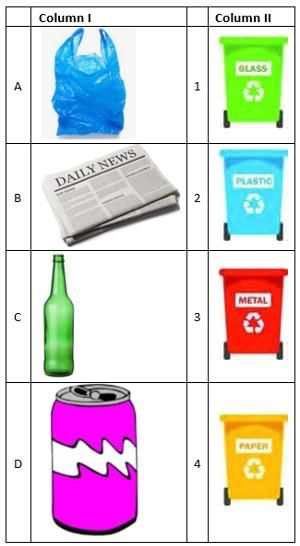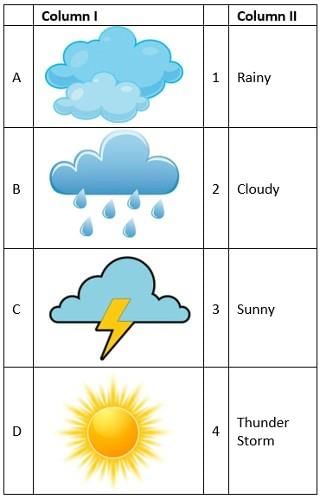All Exams >
Grade 2 >
Science for Grade 2 >
All Questions
All questions of Earth’s Landscape for Grade 2 Exam
_____water is not used for drinking.- a)
 Well
Well - b)
 Handpump
Handpump - c)
 Sea
Sea
Correct answer is option 'C'. Can you explain this answer?
_____water is not used for drinking.
a)
 Well
Wellb)
 Handpump
Handpumpc)
 Sea
Sea|
|
Pranav Singh answered |
Seawater is toxic to humans because your body is unable to get rid of the salt that comes from seawater. Your body's kidneys normally remove excess salt by producing urine, but the body needs freshwater to dilute the salt in your body for the kidneys to work properly.
Which of the following is used as source of drinking water?- a)Tap water
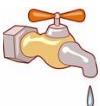
- b)Puddle water

- c)River water

Correct answer is option 'A'. Can you explain this answer?
Which of the following is used as source of drinking water?
a)
Tap water 

b)
Puddle water 

c)
River water 

|
|
Pranav Singh answered |
Tap water:- This is water that is delivered to the point of demand through a network of pipeline. Usually, it is expected to be safe for human consumption and other domestic demand. The water may be clean at it source like ground water, while some time it may require quality improvement through it treatment, example water from the lake, Dams or rivers. There are different types of water treatment methods.
____ is the basic need of our life.- a)Water
- b)Rocks
- c)Stones
Correct answer is option 'A'. Can you explain this answer?
____ is the basic need of our life.
a)
Water
b)
Rocks
c)
Stones
|
|
Pranav Singh answered |
Human beings have certain basic needs. We must have food, water, air, and shelter to survive. If any one of these basic needs is not met, then humans cannot survive.
What do we get from rain?- a)Sunlight
- b)Germs
- c)Water
Correct answer is option 'C'. Can you explain this answer?
What do we get from rain?
a)
Sunlight
b)
Germs
c)
Water
|
|
Pranav Singh answered |
We get water from rain. Ponds and puddles are also filled with rain water. But not only this, the rain water also seeps inside the ground. In the space between the stones, sand, pebbles etc. which are under the soil, water keeps going down by seeping through the holes and crevices. The water that seeps down is groundwater, the same water we get in wells.
What do we call the drops of water that fall from the sky when it rains?- a)Snowflakes
- b)Dew drops
- c)Water drops
- d)Raindrops
Correct answer is option 'D'. Can you explain this answer?
a)
Snowflakes
b)
Dew drops
c)
Water drops
d)
Raindrops
|
|
Aditi Sharma answered |
The drops of water that fall from the sky when it rains are called raindrops. Snowflakes are different and fall as snow, dew drops are the ones on leaves in the morning, and water drops is a general term.
Arrange the following in the increasing order of the size. The Earth, the Moon and the Sun,- a)The Sun - the Moon - the Earth
- b)The Moon - the Sun - the Earth
- c)The Earth - the Moon - the Sun
- d)The Moon - the Earth - the Sun
Correct answer is option 'D'. Can you explain this answer?
Arrange the following in the increasing order of the size. The Earth, the Moon and the Sun,
a)
The Sun - the Moon - the Earth
b)
The Moon - the Sun - the Earth
c)
The Earth - the Moon - the Sun
d)
The Moon - the Earth - the Sun
|
|
Nilesh Khanna answered |
Ascending Order of Size of Earth, Moon, and Sun
The size of celestial bodies is measured in terms of their diameter. The diameter of the Earth, Moon, and Sun are as follows:
- Earth: 12,742 km
- Moon: 3,474 km
- Sun: 1,391,000 km
To arrange them in increasing order of size, we need to start with the smallest and move towards the largest.
1. The Moon
The Moon is the smallest of the three celestial bodies. It has a diameter of 3,474 km.
2. The Earth
The Earth is the second largest of the three celestial bodies. It has a diameter of 12,742 km.
3. The Sun
The Sun is the largest of the three celestial bodies. It has a diameter of 1,391,000 km.
Therefore, the correct order of the size of Earth, Moon, and Sun in ascending order is:
The Moon - The Earth - The Sun (Option D)
The size of celestial bodies is measured in terms of their diameter. The diameter of the Earth, Moon, and Sun are as follows:
- Earth: 12,742 km
- Moon: 3,474 km
- Sun: 1,391,000 km
To arrange them in increasing order of size, we need to start with the smallest and move towards the largest.
1. The Moon
The Moon is the smallest of the three celestial bodies. It has a diameter of 3,474 km.
2. The Earth
The Earth is the second largest of the three celestial bodies. It has a diameter of 12,742 km.
3. The Sun
The Sun is the largest of the three celestial bodies. It has a diameter of 1,391,000 km.
Therefore, the correct order of the size of Earth, Moon, and Sun in ascending order is:
The Moon - The Earth - The Sun (Option D)
Which is the largest river in the world?
- a)Ganges
- b)Nile
- c)Amazon river
- d)Danube river
Correct answer is option 'C'. Can you explain this answer?
Which is the largest river in the world?
a)
Ganges
b)
Nile
c)
Amazon river
d)
Danube river
|
|
Swati Sharma answered |
Amazon is the largest river in the world.
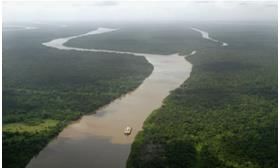

When we observe a ship sailing away from the shore the tower part of the ship disappears first from the sight. Then at last, the flag at the top pole disappears. This is possible only if the Earth is:- a)round shaped
- b)zig zag shaped
- c)slate shaped
- d)flat
Correct answer is option 'A'. Can you explain this answer?
When we observe a ship sailing away from the shore the tower part of the ship disappears first from the sight. Then at last, the flag at the top pole disappears. This is possible only if the Earth is:
a)
round shaped
b)
zig zag shaped
c)
slate shaped
d)
flat
|
|
Naveen Pillai answered |
Explanation:
When a ship sails away from the shore, it appears to go down slowly and gradually. This happens because of the curvature of the Earth's surface. The Earth is round-shaped, and as the ship moves away from the shore, its bottom part disappears first, followed by the middle part, and eventually the top part. This happens because the Earth's surface curves downwards, and eventually, the ship goes below the horizon line.
Proof:
To understand this phenomenon, we can conduct a simple experiment. Take a basketball or any other round object and place a small object on top of it. Now, move the small object away from the center of the basketball. As you move it away, the object will appear to go down, and eventually, it will disappear from sight. This happens because the surface of the basketball curves downwards, just like the surface of the Earth.
Conclusion:
This observation proves that the Earth is round-shaped. If the Earth were flat, the entire ship would remain visible until it went out of sight. However, since the Earth is round, the curvature of its surface causes the ship to disappear gradually as it moves away from the shore.
When a ship sails away from the shore, it appears to go down slowly and gradually. This happens because of the curvature of the Earth's surface. The Earth is round-shaped, and as the ship moves away from the shore, its bottom part disappears first, followed by the middle part, and eventually the top part. This happens because the Earth's surface curves downwards, and eventually, the ship goes below the horizon line.
Proof:
To understand this phenomenon, we can conduct a simple experiment. Take a basketball or any other round object and place a small object on top of it. Now, move the small object away from the center of the basketball. As you move it away, the object will appear to go down, and eventually, it will disappear from sight. This happens because the surface of the basketball curves downwards, just like the surface of the Earth.
Conclusion:
This observation proves that the Earth is round-shaped. If the Earth were flat, the entire ship would remain visible until it went out of sight. However, since the Earth is round, the curvature of its surface causes the ship to disappear gradually as it moves away from the shore.
_____________is the largest ocean in the world.- a)Indian Ocean
- b)Atlantic Ocean
- c)Pacific Ocean
- d)Arctic Ocean
Correct answer is option 'C'. Can you explain this answer?
_____________is the largest ocean in the world.
a)
Indian Ocean
b)
Atlantic Ocean
c)
Pacific Ocean
d)
Arctic Ocean
|
|
Nitin naidu answered |
The Pacific Ocean is the largest ocean in the world.
The Pacific Ocean is the largest and deepest ocean in the world, covering an area of approximately 63 million square miles (165 million square kilometers). It stretches from the Arctic Ocean in the north to the Southern Ocean in the south and is bordered by the continents of Asia and Australia to the west and the Americas to the east.
Key Points:
- The Pacific Ocean covers a significant portion of the Earth's surface, accounting for about one-third of the total area.
- It is larger than all the other oceans combined, including the Atlantic Ocean, Indian Ocean, and Arctic Ocean.
- The Pacific Ocean is shaped like a broad basin, with its widest point located between Indonesia and the coast of Colombia, spanning approximately 19,000 kilometers (11,800 miles).
- It is also the deepest ocean, with its average depth reaching about 12,080 feet (3,682 meters).
- The Pacific Ocean is known for its vast size and numerous islands, including Hawaii, Fiji, Tahiti, and the Galapagos Islands.
- It is home to a diverse range of marine life, including whales, dolphins, sharks, and various species of fish and coral reefs.
- The Pacific Ocean is also significant for its role in global climate patterns, influencing weather systems and ocean currents.
- It experiences the Pacific Decadal Oscillation (PDO), a long-term climate cycle that affects sea surface temperatures and weather patterns in the region.
- The Pacific Ocean is not only important for its ecological value but also for its economic significance, supporting various industries such as fishing, tourism, and shipping.
In conclusion, the Pacific Ocean is the largest ocean in the world, covering a vast area and playing a crucial role in global climate patterns and the global economy.
The Pacific Ocean is the largest and deepest ocean in the world, covering an area of approximately 63 million square miles (165 million square kilometers). It stretches from the Arctic Ocean in the north to the Southern Ocean in the south and is bordered by the continents of Asia and Australia to the west and the Americas to the east.
Key Points:
- The Pacific Ocean covers a significant portion of the Earth's surface, accounting for about one-third of the total area.
- It is larger than all the other oceans combined, including the Atlantic Ocean, Indian Ocean, and Arctic Ocean.
- The Pacific Ocean is shaped like a broad basin, with its widest point located between Indonesia and the coast of Colombia, spanning approximately 19,000 kilometers (11,800 miles).
- It is also the deepest ocean, with its average depth reaching about 12,080 feet (3,682 meters).
- The Pacific Ocean is known for its vast size and numerous islands, including Hawaii, Fiji, Tahiti, and the Galapagos Islands.
- It is home to a diverse range of marine life, including whales, dolphins, sharks, and various species of fish and coral reefs.
- The Pacific Ocean is also significant for its role in global climate patterns, influencing weather systems and ocean currents.
- It experiences the Pacific Decadal Oscillation (PDO), a long-term climate cycle that affects sea surface temperatures and weather patterns in the region.
- The Pacific Ocean is not only important for its ecological value but also for its economic significance, supporting various industries such as fishing, tourism, and shipping.
In conclusion, the Pacific Ocean is the largest ocean in the world, covering a vast area and playing a crucial role in global climate patterns and the global economy.
The full moon day is also called?- a)amavasya
- b)purnima
- c)crescent moon
- d)new moon day
Correct answer is option 'B'. Can you explain this answer?
The full moon day is also called?
a)
amavasya
b)
purnima
c)
crescent moon
d)
new moon day
|
|
Sankar Yadav answered |
Explanation:
The full moon day is also known as "Purnima" in Hindu mythology. It is one of the most important and auspicious days in the lunar calendar. Purnima is derived from the Sanskrit word "Purnamasi" which means "full moon."
Significance of Purnima:
Purnima holds great significance in various cultures and religions. It is believed to be a time of spiritual growth, enlightenment, and divine blessings. Many religious rituals and festivals are celebrated on this day.
Importance in Hinduism:
In Hinduism, Purnima is considered sacred and is associated with various deities and celestial beings. It is believed that on this day, the moon is in its full glory and radiates positive energy. Some of the major Hindu festivals celebrated on Purnima are:
- Raksha Bandhan: A festival celebrating the bond between brothers and sisters.
- Guru Purnima: A day to honor and express gratitude towards spiritual and academic teachers.
- Sharad Purnima: The full moon day in the month of Ashwin, celebrated with dance and music.
Other Cultures and Beliefs:
Purnima is not just significant in Hinduism but also in other cultures and beliefs. Some examples include:
- Buddhist Purnima: Celebrated as Vesak or Buddha Purnima, commemorating the birth, enlightenment, and death of Gautam Buddha.
- Jain Purnima: Celebrated as Paryushana, a time of self-reflection and spiritual purification for Jains.
- Chinese Purnima: Celebrated as Mid-Autumn Festival, where families gather to admire the full moon and enjoy mooncakes.
Conclusion:
The full moon day is known as Purnima and holds immense cultural, religious, and spiritual significance. It is a time for celebration, reflection, and seeking blessings. Purnima is a beautiful phenomenon observed by people worldwide, connecting them with nature and the celestial realm.
The full moon day is also known as "Purnima" in Hindu mythology. It is one of the most important and auspicious days in the lunar calendar. Purnima is derived from the Sanskrit word "Purnamasi" which means "full moon."
Significance of Purnima:
Purnima holds great significance in various cultures and religions. It is believed to be a time of spiritual growth, enlightenment, and divine blessings. Many religious rituals and festivals are celebrated on this day.
Importance in Hinduism:
In Hinduism, Purnima is considered sacred and is associated with various deities and celestial beings. It is believed that on this day, the moon is in its full glory and radiates positive energy. Some of the major Hindu festivals celebrated on Purnima are:
- Raksha Bandhan: A festival celebrating the bond between brothers and sisters.
- Guru Purnima: A day to honor and express gratitude towards spiritual and academic teachers.
- Sharad Purnima: The full moon day in the month of Ashwin, celebrated with dance and music.
Other Cultures and Beliefs:
Purnima is not just significant in Hinduism but also in other cultures and beliefs. Some examples include:
- Buddhist Purnima: Celebrated as Vesak or Buddha Purnima, commemorating the birth, enlightenment, and death of Gautam Buddha.
- Jain Purnima: Celebrated as Paryushana, a time of self-reflection and spiritual purification for Jains.
- Chinese Purnima: Celebrated as Mid-Autumn Festival, where families gather to admire the full moon and enjoy mooncakes.
Conclusion:
The full moon day is known as Purnima and holds immense cultural, religious, and spiritual significance. It is a time for celebration, reflection, and seeking blessings. Purnima is a beautiful phenomenon observed by people worldwide, connecting them with nature and the celestial realm.
Which of the following is NOT a hard rock?- a)Granite
- b)Marble
- c)Diamond
- d)Graphite
Correct answer is option 'D'. Can you explain this answer?
Which of the following is NOT a hard rock?
a)
Granite
b)
Marble
c)
Diamond
d)
Graphite
|
|
Ujwal Verma answered |
Explanation:
A hard rock is a type of rock that has a high resistance to scratching and abrasion. It is characterized by its strong and durable nature. While all of the options given (granite, marble, diamond, and graphite) are types of rocks, only one of them is not considered a hard rock.
Granite:
Granite is a type of igneous rock that is formed from cooled and solidified magma or lava. It is composed mainly of quartz, feldspar, and mica. Granite is known for its durability and strength, making it a popular choice for construction and countertops.
Marble:
Marble is a metamorphic rock that is formed from limestone under heat and pressure. It is composed mainly of calcite or dolomite minerals. Marble is prized for its beauty and is often used in sculptures, building materials, and decorative purposes. While marble is relatively soft compared to other rocks, it is still considered a hard rock.
Diamond:
Diamond is a mineral composed of carbon atoms arranged in a crystal lattice structure. It is the hardest known natural substance, scoring 10 on the Mohs scale of mineral hardness. Diamonds are formed deep within the Earth's mantle under high pressure and temperature. They are commonly used in jewelry and industrial applications such as cutting and grinding due to their extreme hardness.
Graphite:
Graphite is a form of carbon that occurs naturally as a mineral. It is composed of stacked layers of carbon atoms arranged in a hexagonal lattice structure. Graphite is very soft and has a low hardness value on the Mohs scale. It is commonly used in pencils and lubricants due to its slippery and low-friction properties. Unlike the other options, graphite is not considered a hard rock.
Therefore, the correct answer is option 'D' (Graphite).
A hard rock is a type of rock that has a high resistance to scratching and abrasion. It is characterized by its strong and durable nature. While all of the options given (granite, marble, diamond, and graphite) are types of rocks, only one of them is not considered a hard rock.
Granite:
Granite is a type of igneous rock that is formed from cooled and solidified magma or lava. It is composed mainly of quartz, feldspar, and mica. Granite is known for its durability and strength, making it a popular choice for construction and countertops.
Marble:
Marble is a metamorphic rock that is formed from limestone under heat and pressure. It is composed mainly of calcite or dolomite minerals. Marble is prized for its beauty and is often used in sculptures, building materials, and decorative purposes. While marble is relatively soft compared to other rocks, it is still considered a hard rock.
Diamond:
Diamond is a mineral composed of carbon atoms arranged in a crystal lattice structure. It is the hardest known natural substance, scoring 10 on the Mohs scale of mineral hardness. Diamonds are formed deep within the Earth's mantle under high pressure and temperature. They are commonly used in jewelry and industrial applications such as cutting and grinding due to their extreme hardness.
Graphite:
Graphite is a form of carbon that occurs naturally as a mineral. It is composed of stacked layers of carbon atoms arranged in a hexagonal lattice structure. Graphite is very soft and has a low hardness value on the Mohs scale. It is commonly used in pencils and lubricants due to its slippery and low-friction properties. Unlike the other options, graphite is not considered a hard rock.
Therefore, the correct answer is option 'D' (Graphite).
What shape is a glass of water?- a)Square
- b)Round
- c)Triangle
- d)It doesn't have a shape
Correct answer is option 'D'. Can you explain this answer?
a)
Square
b)
Round
c)
Triangle
d)
It doesn't have a shape
|
|
Aditi Sharma answered |
A glass of water doesn't have a specific shape because it takes the shape of the container it's in. It's a liquid that fills up the space inside the glass.
What is the shape of the Earth?- a)Perfect square
- b)Round like a ball
- c)Flat like a paper
- d)Triangle
Correct answer is option 'B'. Can you explain this answer?
a)
Perfect square
b)
Round like a ball
c)
Flat like a paper
d)
Triangle
|
|
Akash Tiwari answered |
Earth looks round, like a ball, but is slightly flat at the top and bottom.
It is a bit wider in the middle, like an orange.
Photos from space confirm this shape.
It is a bit wider in the middle, like an orange.
Photos from space confirm this shape.
How many oceans are on Earth?- a)7
- b)5
- c)3
- d)6
Correct answer is option 'B'. Can you explain this answer?
How many oceans are on Earth?
a)
7
b)
5
c)
3
d)
6
|
|
Ravi dey answered |
Explanation:
Ocean is a large body of salt water that covers a vast majority of the Earth's surface. There are a total of 5 oceans on Earth.
Atlantic Ocean: The Atlantic Ocean is the second-largest ocean in the world, covering approximately 20% of the Earth's surface.
Pacific Ocean: The Pacific Ocean is the largest ocean in the world, covering approximately 30% of the Earth's surface.
Indian Ocean: The Indian Ocean is the third-largest ocean in the world and is located between Africa, Asia, Australia, and the Antarctic.
Southern Ocean: The Southern Ocean is the newest named ocean and is located around the continent of Antarctica.
Arctic Ocean: The Arctic Ocean is the smallest and shallowest of the world's oceans and is located in the Arctic region.
These 5 oceans make up the vast majority of the Earth's water bodies and play a crucial role in regulating the planet's climate and weather patterns.
Ocean is a large body of salt water that covers a vast majority of the Earth's surface. There are a total of 5 oceans on Earth.
Atlantic Ocean: The Atlantic Ocean is the second-largest ocean in the world, covering approximately 20% of the Earth's surface.
Pacific Ocean: The Pacific Ocean is the largest ocean in the world, covering approximately 30% of the Earth's surface.
Indian Ocean: The Indian Ocean is the third-largest ocean in the world and is located between Africa, Asia, Australia, and the Antarctic.
Southern Ocean: The Southern Ocean is the newest named ocean and is located around the continent of Antarctica.
Arctic Ocean: The Arctic Ocean is the smallest and shallowest of the world's oceans and is located in the Arctic region.
These 5 oceans make up the vast majority of the Earth's water bodies and play a crucial role in regulating the planet's climate and weather patterns.
How much percentage of Earth is covered with water?- a)70%
- b)30%
- c)50%
- d)10%
Correct answer is option 'A'. Can you explain this answer?
How much percentage of Earth is covered with water?
a)
70%
b)
30%
c)
50%
d)
10%
|
|
Pranav Singh answered |
70% of Earth is covered with water, while 30% is covered with land.
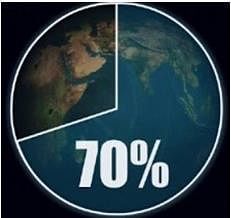

A soft, white rock that is used to write on blackboards is- a)graphite.
- b)chalk.
- c)talc.
- d)quartz.
Correct answer is option 'B'. Can you explain this answer?
A soft, white rock that is used to write on blackboards is
a)
graphite.
b)
chalk.
c)
talc.
d)
quartz.
|
|
Atul menon answered |
Chalk as a Writing Tool
Chalk is a soft, white rock that is commonly used to write on blackboards. Here's why chalk is the correct answer for this question:
Composition:
- Chalk is primarily composed of calcium carbonate, which gives it its characteristic white color and soft texture.
- The softness of chalk makes it easy to write with on a blackboard, as it leaves a visible mark without damaging the surface.
Usage on Blackboards:
- Chalk has been used as a writing tool on blackboards for centuries due to its effectiveness and affordability.
- When writing with chalk on a blackboard, the calcium carbonate in the chalk leaves a white mark on the dark surface, making it highly visible.
Alternative Options:
- Graphite is a dark, metallic mineral used in pencils, not chalk.
- Talc is a soft mineral often used in cosmetics and baby powder, not chalk.
- Quartz is a hard mineral commonly used in jewelry and construction, not chalk.
In conclusion, chalk is the correct answer for a soft, white rock used to write on blackboards due to its composition, historical usage, and distinctive properties that make it suitable for this purpose.
Chalk is a soft, white rock that is commonly used to write on blackboards. Here's why chalk is the correct answer for this question:
Composition:
- Chalk is primarily composed of calcium carbonate, which gives it its characteristic white color and soft texture.
- The softness of chalk makes it easy to write with on a blackboard, as it leaves a visible mark without damaging the surface.
Usage on Blackboards:
- Chalk has been used as a writing tool on blackboards for centuries due to its effectiveness and affordability.
- When writing with chalk on a blackboard, the calcium carbonate in the chalk leaves a white mark on the dark surface, making it highly visible.
Alternative Options:
- Graphite is a dark, metallic mineral used in pencils, not chalk.
- Talc is a soft mineral often used in cosmetics and baby powder, not chalk.
- Quartz is a hard mineral commonly used in jewelry and construction, not chalk.
In conclusion, chalk is the correct answer for a soft, white rock used to write on blackboards due to its composition, historical usage, and distinctive properties that make it suitable for this purpose.
Which of the following is NOT correct about diamond?- a)It is transparent with no colour.
- b)It can be used for cutting glass.
- c)It is used for making jewellery.
- d)It is a soft rock.
Correct answer is option 'D'. Can you explain this answer?
Which of the following is NOT correct about diamond?
a)
It is transparent with no colour.
b)
It can be used for cutting glass.
c)
It is used for making jewellery.
d)
It is a soft rock.
|
|
Manasa Banerjee answered |
Explanation:
Introduction:
Diamond is a precious gemstone that has been highly valued for its beauty and durability for centuries. It is one of the hardest naturally occurring substances found on Earth.
Properties of Diamond:
1. Transparency and Color: Diamond is transparent, meaning it allows light to pass through it. It is colorless, but it can also come in various colors such as yellow, blue, pink, etc., depending on impurities present in the crystal lattice. So, option (a) is correct.
2. Cutting Glass: Diamond is extremely hard and has a high refractive index, which means it can be used for cutting and shaping other materials. Due to its hardness, it can easily scratch and cut glass. This property makes diamond an ideal tool for industrial use, especially in cutting and grinding operations. So, option (b) is correct.
3. Use in Jewellery: Diamond is highly prized for its beauty and is extensively used in making jewellery. It is cut into various shapes and sizes, such as round, princess, oval, etc., and set in precious metals like gold or platinum to create stunning pieces of jewellery. Diamonds are often used as center stones in engagement rings, earrings, necklaces, and bracelets. So, option (c) is correct.
4. Hardness: Diamond is the hardest known natural material. It scores a perfect 10 on the Mohs scale of mineral hardness, which measures a mineral's resistance to scratching. This means that diamond is extremely durable and resistant to wear. It can only be scratched by another diamond. So, option (d) is incorrect. Diamond is not a soft rock but the hardest naturally occurring substance.
Conclusion:
In conclusion, diamond is a transparent gemstone that can cut glass and is extensively used in jewellery making. It is not a soft rock but the hardest natural material. Therefore, option (d) is not correct.
Introduction:
Diamond is a precious gemstone that has been highly valued for its beauty and durability for centuries. It is one of the hardest naturally occurring substances found on Earth.
Properties of Diamond:
1. Transparency and Color: Diamond is transparent, meaning it allows light to pass through it. It is colorless, but it can also come in various colors such as yellow, blue, pink, etc., depending on impurities present in the crystal lattice. So, option (a) is correct.
2. Cutting Glass: Diamond is extremely hard and has a high refractive index, which means it can be used for cutting and shaping other materials. Due to its hardness, it can easily scratch and cut glass. This property makes diamond an ideal tool for industrial use, especially in cutting and grinding operations. So, option (b) is correct.
3. Use in Jewellery: Diamond is highly prized for its beauty and is extensively used in making jewellery. It is cut into various shapes and sizes, such as round, princess, oval, etc., and set in precious metals like gold or platinum to create stunning pieces of jewellery. Diamonds are often used as center stones in engagement rings, earrings, necklaces, and bracelets. So, option (c) is correct.
4. Hardness: Diamond is the hardest known natural material. It scores a perfect 10 on the Mohs scale of mineral hardness, which measures a mineral's resistance to scratching. This means that diamond is extremely durable and resistant to wear. It can only be scratched by another diamond. So, option (d) is incorrect. Diamond is not a soft rock but the hardest naturally occurring substance.
Conclusion:
In conclusion, diamond is a transparent gemstone that can cut glass and is extensively used in jewellery making. It is not a soft rock but the hardest natural material. Therefore, option (d) is not correct.
Why is water important for plants?- a)Plants can dance in water
- b)Plants use water to breathe
- c)Water makes plants grow candy
- d)Plants don't need water
Correct answer is option 'B'. Can you explain this answer?
a)
Plants can dance in water
b)
Plants use water to breathe
c)
Water makes plants grow candy
d)
Plants don't need water
|
|
Aarav Choudhury answered |
Importance of Water for Plants
Water is essential for plants for several reasons, and it plays a crucial role in their survival and growth.
1. Photosynthesis
- Water is vital for the process of photosynthesis, where plants convert sunlight into energy.
- During photosynthesis, plants take in carbon dioxide from the air and water from the soil to produce glucose and oxygen.
2. Nutrient Transport
- Water helps in transporting nutrients and minerals from the soil into the plant.
- It acts as a solvent, allowing essential nutrients to dissolve and be absorbed through the roots.
3. Turgor Pressure
- Water helps maintain turgor pressure in plant cells, which keeps them rigid and upright.
- This pressure is crucial for maintaining the plant’s structure and preventing wilting.
4. Temperature Regulation
- Water plays a role in regulating the temperature of plants.
- Through the process of transpiration, plants release water vapor which cools them down.
5. Cellular Functions
- Water is involved in various cellular processes within the plant.
- It is necessary for biochemical reactions and helps in the overall functioning of the plant cells.
In conclusion, while the idea of plants "breathing" may sound unusual, they indeed require water to absorb carbon dioxide and carry out vital processes that sustain their life. Thus, option 'B' is the correct answer, emphasizing the importance of water for plant health and growth.
Water is essential for plants for several reasons, and it plays a crucial role in their survival and growth.
1. Photosynthesis
- Water is vital for the process of photosynthesis, where plants convert sunlight into energy.
- During photosynthesis, plants take in carbon dioxide from the air and water from the soil to produce glucose and oxygen.
2. Nutrient Transport
- Water helps in transporting nutrients and minerals from the soil into the plant.
- It acts as a solvent, allowing essential nutrients to dissolve and be absorbed through the roots.
3. Turgor Pressure
- Water helps maintain turgor pressure in plant cells, which keeps them rigid and upright.
- This pressure is crucial for maintaining the plant’s structure and preventing wilting.
4. Temperature Regulation
- Water plays a role in regulating the temperature of plants.
- Through the process of transpiration, plants release water vapor which cools them down.
5. Cellular Functions
- Water is involved in various cellular processes within the plant.
- It is necessary for biochemical reactions and helps in the overall functioning of the plant cells.
In conclusion, while the idea of plants "breathing" may sound unusual, they indeed require water to absorb carbon dioxide and carry out vital processes that sustain their life. Thus, option 'B' is the correct answer, emphasizing the importance of water for plant health and growth.
Which of the following rocks is hard, rough and reddish?- a)Granite
- b)Marble
- c)Sandstone
- d)Slate
Correct answer is option 'C'. Can you explain this answer?
Which of the following rocks is hard, rough and reddish?
a)
Granite
b)
Marble
c)
Sandstone
d)
Slate
|
|
Debolina Joshi answered |
Sandstone
Sandstone is a type of rock that is hard, rough, and reddish in color. Let's explore why sandstone fits this description:
Hardness:
- Sandstone is a hard rock that is composed of sand-sized grains of mineral, rock, or organic material. Its compacted nature gives it a sturdy and solid structure, making it a hard rock.
Rough Texture:
- Sandstone typically has a rough texture due to its composition of sand-sized grains. These grains create a coarse surface that feels rough to the touch.
Reddish Color:
- Sandstone can come in a variety of colors, including red. The presence of iron oxide in the rock gives it a reddish hue. This distinctive coloration sets sandstone apart from other types of rocks.
In summary, sandstone is a hard, rough, and reddish rock that is commonly found in various geological formations. Its unique characteristics make it a popular choice for construction and decorative purposes.
Sandstone is a type of rock that is hard, rough, and reddish in color. Let's explore why sandstone fits this description:
Hardness:
- Sandstone is a hard rock that is composed of sand-sized grains of mineral, rock, or organic material. Its compacted nature gives it a sturdy and solid structure, making it a hard rock.
Rough Texture:
- Sandstone typically has a rough texture due to its composition of sand-sized grains. These grains create a coarse surface that feels rough to the touch.
Reddish Color:
- Sandstone can come in a variety of colors, including red. The presence of iron oxide in the rock gives it a reddish hue. This distinctive coloration sets sandstone apart from other types of rocks.
In summary, sandstone is a hard, rough, and reddish rock that is commonly found in various geological formations. Its unique characteristics make it a popular choice for construction and decorative purposes.
Water and wind can break rock into smaller pieces. What happens to these pieces when they break up?- a)Plants use them for energy.
- b)They become part of the soil.
- c)They become food for animals.
- d)They turn into earthworms.
Correct answer is option 'B'. Can you explain this answer?
Water and wind can break rock into smaller pieces. What happens to these pieces when they break up?
a)
Plants use them for energy.
b)
They become part of the soil.
c)
They become food for animals.
d)
They turn into earthworms.
|
|
Niti verma answered |
What happens to the pieces when rocks break up?
When rocks are broken up by water and wind, the smaller pieces that are produced are not simply discarded or destroyed. Instead, they go through a natural process that allows them to become an essential part of the environment. The correct answer to the question is option 'B' - they become part of the soil. Let's explore this in more detail.
1. Weathering and erosion:
- Water and wind are agents of weathering and erosion, meaning they have the ability to break down rocks into smaller pieces.
- Water enters the cracks and crevices of rocks, and when it freezes and expands, it exerts pressure that causes the rock to break apart.
- Wind can carry small particles such as sand, which can act as abrasives, wearing down rocks over time.
2. Formation of soil:
- The smaller pieces of rock that result from weathering and erosion are called sediment.
- Sediment can vary in size, from tiny particles like clay to larger fragments like sand and gravel.
- Over time, these sediments accumulate and mix with organic matter, such as dead plants and animals, to form soil.
- The process of soil formation is called pedogenesis.
3. Importance of soil:
- Soil is a vital resource for plants, animals, and humans.
- It provides a medium for plant growth, supplying nutrients, water, and anchorage for roots.
- Soil also serves as a habitat for a wide range of organisms, including earthworms, insects, microorganisms, and burrowing animals.
- It acts as a filter, purifying water as it percolates through the soil layers.
4. Nutrient cycling:
- As rocks break down and become part of the soil, they release minerals and nutrients that are essential for plant growth.
- This process, known as nutrient cycling, ensures that these vital elements are continuously recycled and available for use by living organisms.
Conclusion:
In summary, when rocks break up due to the forces of water and wind, the smaller pieces become part of the soil. This process is important for the formation of soil, which provides essential nutrients and support for plant growth, serves as a habitat for various organisms, and plays a crucial role in nutrient cycling.
When rocks are broken up by water and wind, the smaller pieces that are produced are not simply discarded or destroyed. Instead, they go through a natural process that allows them to become an essential part of the environment. The correct answer to the question is option 'B' - they become part of the soil. Let's explore this in more detail.
1. Weathering and erosion:
- Water and wind are agents of weathering and erosion, meaning they have the ability to break down rocks into smaller pieces.
- Water enters the cracks and crevices of rocks, and when it freezes and expands, it exerts pressure that causes the rock to break apart.
- Wind can carry small particles such as sand, which can act as abrasives, wearing down rocks over time.
2. Formation of soil:
- The smaller pieces of rock that result from weathering and erosion are called sediment.
- Sediment can vary in size, from tiny particles like clay to larger fragments like sand and gravel.
- Over time, these sediments accumulate and mix with organic matter, such as dead plants and animals, to form soil.
- The process of soil formation is called pedogenesis.
3. Importance of soil:
- Soil is a vital resource for plants, animals, and humans.
- It provides a medium for plant growth, supplying nutrients, water, and anchorage for roots.
- Soil also serves as a habitat for a wide range of organisms, including earthworms, insects, microorganisms, and burrowing animals.
- It acts as a filter, purifying water as it percolates through the soil layers.
4. Nutrient cycling:
- As rocks break down and become part of the soil, they release minerals and nutrients that are essential for plant growth.
- This process, known as nutrient cycling, ensures that these vital elements are continuously recycled and available for use by living organisms.
Conclusion:
In summary, when rocks break up due to the forces of water and wind, the smaller pieces become part of the soil. This process is important for the formation of soil, which provides essential nutrients and support for plant growth, serves as a habitat for various organisms, and plays a crucial role in nutrient cycling.
The shadow cast by the Earth on the Moon during eclipse is.- a)shaped
- b)line shaped
- c)rectangle shaped
- d)round shaped
Correct answer is option 'D'. Can you explain this answer?
The shadow cast by the Earth on the Moon during eclipse is.
a)
shaped
b)
line shaped
c)
rectangle shaped
d)
round shaped
|
|
Arnav Nambiar answered |
The shadow cast by the Earth on the Moon during an eclipse is round shaped.
Eclipses occur when one celestial body moves into the shadow of another. In the case of a lunar eclipse, the Earth moves between the Sun and the Moon, casting a shadow on the Moon's surface. This shadow is responsible for the darkening or reddening of the Moon during an eclipse.
1. The Earth's Shadow
The Earth's shadow has two parts: the penumbra and the umbra. The penumbra is the outer part of the shadow and is not completely dark. It gradually gets darker towards the center, where the umbra begins. The umbra is the inner part of the shadow and is completely dark.
2. Shape of the Earth's Shadow
The shape of the Earth's shadow is round. This is because the Earth is a spherical shape, and when it blocks the Sun's light, it creates a circular shadow. The curvature of the Earth determines the shape of the shadow.
3. Projection onto the Moon
When the Earth casts its shadow onto the Moon during a lunar eclipse, the round shape of the shadow is projected onto the Moon's surface. This is why during a total lunar eclipse, we see a perfectly round shadow covering the Moon. The shadow may appear slightly distorted due to the irregularities on the Moon's surface, but overall, it retains its round shape.
4. Variation in Shadow Size
The size of the Earth's shadow on the Moon can vary during different stages of an eclipse. At the beginning and end of a lunar eclipse, when the Moon is partially in the Earth's shadow, the shadow may appear slightly elongated. However, during a total lunar eclipse, when the Moon is fully within the umbra, the shadow takes on a more distinct and round shape.
In conclusion, the shadow cast by the Earth on the Moon during an eclipse is round shaped. This is due to the Earth's spherical shape and the projection of its shadow onto the Moon's surface.
Eclipses occur when one celestial body moves into the shadow of another. In the case of a lunar eclipse, the Earth moves between the Sun and the Moon, casting a shadow on the Moon's surface. This shadow is responsible for the darkening or reddening of the Moon during an eclipse.
1. The Earth's Shadow
The Earth's shadow has two parts: the penumbra and the umbra. The penumbra is the outer part of the shadow and is not completely dark. It gradually gets darker towards the center, where the umbra begins. The umbra is the inner part of the shadow and is completely dark.
2. Shape of the Earth's Shadow
The shape of the Earth's shadow is round. This is because the Earth is a spherical shape, and when it blocks the Sun's light, it creates a circular shadow. The curvature of the Earth determines the shape of the shadow.
3. Projection onto the Moon
When the Earth casts its shadow onto the Moon during a lunar eclipse, the round shape of the shadow is projected onto the Moon's surface. This is why during a total lunar eclipse, we see a perfectly round shadow covering the Moon. The shadow may appear slightly distorted due to the irregularities on the Moon's surface, but overall, it retains its round shape.
4. Variation in Shadow Size
The size of the Earth's shadow on the Moon can vary during different stages of an eclipse. At the beginning and end of a lunar eclipse, when the Moon is partially in the Earth's shadow, the shadow may appear slightly elongated. However, during a total lunar eclipse, when the Moon is fully within the umbra, the shadow takes on a more distinct and round shape.
In conclusion, the shadow cast by the Earth on the Moon during an eclipse is round shaped. This is due to the Earth's spherical shape and the projection of its shadow onto the Moon's surface.
What surrounds Earth and gives us air to breathe?- a)Atmosphere
- b)Clouds
- c)Sunlight
- d)Rain
Correct answer is option 'A'. Can you explain this answer?
a)
Atmosphere
b)
Clouds
c)
Sunlight
d)
Rain
|
|
Mihir Pillai answered |
What is the Atmosphere?
The atmosphere is a layer of gases that surrounds the Earth. It is essential for life and plays a crucial role in various natural processes.
Composition of the Atmosphere
- The atmosphere is made up of about 78% nitrogen, 21% oxygen, and small amounts of other gases like carbon dioxide, argon, and water vapor.
- Oxygen is the most important component as it is vital for humans and animals to breathe.
Functions of the Atmosphere
- Provides Air to Breathe: The atmosphere contains oxygen, which is necessary for respiration in living organisms.
- Regulates Temperature: It helps to keep the Earth's temperature stable by trapping heat from the sun, preventing extreme temperature changes.
- Protects from Harmful Radiation: The atmosphere absorbs and reflects harmful solar radiation, safeguarding life on Earth.
- Weather and Climate: It is responsible for weather patterns and climate, influencing rainfall, temperature, and wind.
Conclusion
Thus, the atmosphere is fundamental for sustaining life on Earth by providing the air we breathe, regulating temperature, and protecting us from harmful elements. It is vital to understand and appreciate this protective layer that surrounds our planet.
The atmosphere is a layer of gases that surrounds the Earth. It is essential for life and plays a crucial role in various natural processes.
Composition of the Atmosphere
- The atmosphere is made up of about 78% nitrogen, 21% oxygen, and small amounts of other gases like carbon dioxide, argon, and water vapor.
- Oxygen is the most important component as it is vital for humans and animals to breathe.
Functions of the Atmosphere
- Provides Air to Breathe: The atmosphere contains oxygen, which is necessary for respiration in living organisms.
- Regulates Temperature: It helps to keep the Earth's temperature stable by trapping heat from the sun, preventing extreme temperature changes.
- Protects from Harmful Radiation: The atmosphere absorbs and reflects harmful solar radiation, safeguarding life on Earth.
- Weather and Climate: It is responsible for weather patterns and climate, influencing rainfall, temperature, and wind.
Conclusion
Thus, the atmosphere is fundamental for sustaining life on Earth by providing the air we breathe, regulating temperature, and protecting us from harmful elements. It is vital to understand and appreciate this protective layer that surrounds our planet.
Pebbles are- a)a kind of rock
- b)a kind of mineral
- c)a kind of soil
- d)all of these
Correct answer is option 'A'. Can you explain this answer?
Pebbles are
a)
a kind of rock
b)
a kind of mineral
c)
a kind of soil
d)
all of these
|
|
Malavika Sen answered |
Explanation:
Pebbles are a kind of rock:
- Pebbles are small, rounded rocks that are typically smooth and often found on beaches, riverbeds, or in other natural environments.
- They are formed through the natural process of erosion and weathering, which breaks down larger rocks into smaller pieces over time.
- Pebbles are composed of various minerals and can vary in color, size, and shape depending on their geological origin.
Pebbles are not a kind of mineral or soil:
- While pebbles are made up of minerals, they are not classified as a specific type of mineral themselves.
- Similarly, pebbles are not considered soil, as soil is a mixture of organic and inorganic materials that support plant life and is typically found on the Earth's surface.
Conclusion:
Pebbles are a type of rock that can be found in various natural environments, and they are formed through the process of erosion and weathering. They are not classified as a mineral or soil, but rather as small, rounded rocks composed of different minerals.
Pebbles are a kind of rock:
- Pebbles are small, rounded rocks that are typically smooth and often found on beaches, riverbeds, or in other natural environments.
- They are formed through the natural process of erosion and weathering, which breaks down larger rocks into smaller pieces over time.
- Pebbles are composed of various minerals and can vary in color, size, and shape depending on their geological origin.
Pebbles are not a kind of mineral or soil:
- While pebbles are made up of minerals, they are not classified as a specific type of mineral themselves.
- Similarly, pebbles are not considered soil, as soil is a mixture of organic and inorganic materials that support plant life and is typically found on the Earth's surface.
Conclusion:
Pebbles are a type of rock that can be found in various natural environments, and they are formed through the process of erosion and weathering. They are not classified as a mineral or soil, but rather as small, rounded rocks composed of different minerals.
How much of the Earth is covered with water?- a)All of it
- b)Two-thirds
- c)One-third
- d)Half
Correct answer is option 'B'. Can you explain this answer?
a)
All of it
b)
Two-thirds
c)
One-third
d)
Half
|
|
Arnav Nambiar answered |
Understanding Earth's Water Coverage
Earth is often referred to as the "Blue Planet" due to its vast oceans and water bodies. Approximately two-thirds of the planet's surface is covered with water.
Water Distribution
- Oceans: About 97% of Earth's water is found in the oceans, which are salty and cover around 71% of the Earth's surface.
- Freshwater Sources: The remaining 3% of Earth's water is fresh, primarily found in glaciers, ice caps, rivers, lakes, and underground aquifers.
Importance of Water Coverage
- Climate Regulation: Water plays a crucial role in regulating the Earth's climate and weather patterns.
- Habitats: Oceans and freshwater bodies provide essential habitats for countless species of plants and animals.
- Human Needs: Water is vital for human survival, agriculture, and industry, making its abundance critical for life.
Conclusion
In summary, the correct answer is option 'B' because two-thirds of the Earth's surface is indeed covered by water, highlighting the importance of this resource in sustaining life and maintaining ecological balance.
Earth is often referred to as the "Blue Planet" due to its vast oceans and water bodies. Approximately two-thirds of the planet's surface is covered with water.
Water Distribution
- Oceans: About 97% of Earth's water is found in the oceans, which are salty and cover around 71% of the Earth's surface.
- Freshwater Sources: The remaining 3% of Earth's water is fresh, primarily found in glaciers, ice caps, rivers, lakes, and underground aquifers.
Importance of Water Coverage
- Climate Regulation: Water plays a crucial role in regulating the Earth's climate and weather patterns.
- Habitats: Oceans and freshwater bodies provide essential habitats for countless species of plants and animals.
- Human Needs: Water is vital for human survival, agriculture, and industry, making its abundance critical for life.
Conclusion
In summary, the correct answer is option 'B' because two-thirds of the Earth's surface is indeed covered by water, highlighting the importance of this resource in sustaining life and maintaining ecological balance.
Why can Earth support life?- a)It has air, water, and land
- b)It spins quickly
- c)It is close to the Moon
- d)It has no water
Correct answer is option 'A'. Can you explain this answer?
a)
It has air, water, and land
b)
It spins quickly
c)
It is close to the Moon
d)
It has no water
|
|
Akash Tiwari answered |
Earth has fresh air to breathe.
It has water to drink and use.
Land is needed to grow food and build homes.
It has water to drink and use.
Land is needed to grow food and build homes.
Which of the following is the largest continent in the world?- a)Australia
- b)Asia
- c)Antarctica
- d)Africa
Correct answer is option 'B'. Can you explain this answer?
Which of the following is the largest continent in the world?
a)
Australia
b)
Asia
c)
Antarctica
d)
Africa
|
|
Harsh mehra answered |
Asia is the largest continent in the world.
Asia is the largest continent in the world in terms of both land area and population. Here are some key reasons why Asia holds the title of the largest continent:
- Land Area: Asia covers a vast area of about 44.58 million square kilometers, making it the largest continent on Earth. It is home to diverse landscapes, including deserts, mountains, plains, forests, and coastlines.
- Population: Asia is also the most populous continent, with over 4.6 billion people living within its borders. This accounts for more than half of the world's total population.
- Diversity: Asia is incredibly diverse, both culturally and geographically. It is home to numerous countries with rich histories, languages, traditions, and religions. The continent also boasts a wide range of climates and ecosystems.
- Economic Power: Many of the world's largest economies, such as China, Japan, India, and South Korea, are located in Asia. The continent plays a crucial role in global trade and commerce.
In conclusion, Asia's vast land area, large population, diversity, and economic significance all contribute to its status as the largest continent in the world.
Asia is the largest continent in the world in terms of both land area and population. Here are some key reasons why Asia holds the title of the largest continent:
- Land Area: Asia covers a vast area of about 44.58 million square kilometers, making it the largest continent on Earth. It is home to diverse landscapes, including deserts, mountains, plains, forests, and coastlines.
- Population: Asia is also the most populous continent, with over 4.6 billion people living within its borders. This accounts for more than half of the world's total population.
- Diversity: Asia is incredibly diverse, both culturally and geographically. It is home to numerous countries with rich histories, languages, traditions, and religions. The continent also boasts a wide range of climates and ecosystems.
- Economic Power: Many of the world's largest economies, such as China, Japan, India, and South Korea, are located in Asia. The continent plays a crucial role in global trade and commerce.
In conclusion, Asia's vast land area, large population, diversity, and economic significance all contribute to its status as the largest continent in the world.
In which of the following seasons, weather is neither too hot nor too cold?- a)Spring
- b)Summer
- c)Winter
- d)None of the above
Correct answer is option 'A'. Can you explain this answer?
In which of the following seasons, weather is neither too hot nor too cold?
a)
Spring
b)
Summer
c)
Winter
d)
None of the above
|
|
Sara singh answered |
Seasons and Weather
There are four seasons in a year, and each season has its own characteristics in terms of weather. Let's take a closer look at each season and the weather it brings.
Spring
Spring is the season that comes after winter and before summer. It is the season of new beginnings, and the weather during this time is neither too hot nor too cold. The temperature during spring is usually pleasant, with cool mornings and evenings and warm afternoons. The average temperature during spring is around 15°C to 20°C.
Summer
Summer is the season that comes after spring and before autumn. It is the hottest season of the year, and the weather during this time is usually very hot and dry. The temperature during summer can range from 25°C to 40°C or more, depending on the location.
Winter
Winter is the season that comes after autumn and before spring. It is the coldest season of the year, and the weather during this time is usually very cold and snowy. The temperature during winter can range from -10°C to 10°C, depending on the location.
None of the Above
Since both summer and winter have extreme temperatures, neither of them can be considered a season with weather that is neither too hot nor too cold. Therefore, the correct answer is option A, which is spring.
Conclusion
In conclusion, spring is the season that has weather that is neither too hot nor too cold. It is a season of new beginnings, and the temperature during this time is usually pleasant, with cool mornings and evenings and warm afternoons.
There are four seasons in a year, and each season has its own characteristics in terms of weather. Let's take a closer look at each season and the weather it brings.
Spring
Spring is the season that comes after winter and before summer. It is the season of new beginnings, and the weather during this time is neither too hot nor too cold. The temperature during spring is usually pleasant, with cool mornings and evenings and warm afternoons. The average temperature during spring is around 15°C to 20°C.
Summer
Summer is the season that comes after spring and before autumn. It is the hottest season of the year, and the weather during this time is usually very hot and dry. The temperature during summer can range from 25°C to 40°C or more, depending on the location.
Winter
Winter is the season that comes after autumn and before spring. It is the coldest season of the year, and the weather during this time is usually very cold and snowy. The temperature during winter can range from -10°C to 10°C, depending on the location.
None of the Above
Since both summer and winter have extreme temperatures, neither of them can be considered a season with weather that is neither too hot nor too cold. Therefore, the correct answer is option A, which is spring.
Conclusion
In conclusion, spring is the season that has weather that is neither too hot nor too cold. It is a season of new beginnings, and the temperature during this time is usually pleasant, with cool mornings and evenings and warm afternoons.
Which of the following statement is incorrect?- a)We should turn off taps after using water
- b)We can use rainwater for cooking
- c)We can use rainwater for cleaning floors
Correct answer is option 'B'. Can you explain this answer?
Which of the following statement is incorrect?
a)
We should turn off taps after using water
b)
We can use rainwater for cooking
c)
We can use rainwater for cleaning floors
|
|
Pranav Singh answered |
You can use the stored rainwater from your tank to clean your kitchen—that is, for washing and cleaning non–food preparation work surfaces, mopping floors, cleaning rags, etc. However, you cannot use untreated rainwater in food preparation and cleaning your kitchenware, utensils, etc
Which of the following is a star?- a)Sun
- b)Moon
- c)Earth
- d)Comet
Correct answer is option 'A'. Can you explain this answer?
Which of the following is a star?
a)
Sun
b)
Moon
c)
Earth
d)
Comet
|
|
Glitz Classes answered |
Answer:
Star:
- A star is a celestial object that generates its own light and energy through nuclear fusion in its core.
- Stars are composed primarily of hydrogen and helium.
- They exist in different sizes, colors, and temperatures.
- Stars can be categorized into different types such as main sequence stars, giant stars, dwarf stars, and supergiant stars.
- The Sun is considered a star.
- It is located at the center of our solar system.
- The Sun is classified as a main sequence star of spectral type G2V.
- It is approximately 4.6 billion years old and will continue to shine for several billion more years.
- The Sun's energy sustains life on Earth through the process of photosynthesis and provides heat and light.
Moon:
- The Moon is Earth's natural satellite.
- It does not generate its own light but reflects the sunlight.
- The Moon orbits around the Earth and takes about 27.3 days to complete one revolution.
- It has phases, such as full moon, new moon, crescent moon, and gibbous moon, depending on its position relative to the Earth and the Sun.
- The Moon has a rocky surface and lacks an atmosphere.
- It influences tides on Earth due to its gravitational pull.
Earth:
- Earth is the third planet from the Sun in our solar system.
- It is a terrestrial planet with a solid surface and an atmosphere.
- Earth is the only known planet to support life.
- It has a diverse range of ecosystems and is home to millions of species.
- Earth has a magnetic field that protects it from harmful solar radiation.
- It takes approximately 365.25 days to complete one revolution around the Sun.
Comet:
- A comet is a small celestial object composed of ice, dust, and rock.
- Comets have a highly elliptical orbit around the Sun.
- When a comet approaches the Sun, the heat causes the ice to vaporize, forming a glowing coma and often a tail.
- Comets are often visible from Earth during their close approach to the Sun.
Conclusion:
- Among the given options, the Sun is the star.
- The Moon is a satellite, Earth is a planet, and a comet is a different type of celestial object.
Star:
- A star is a celestial object that generates its own light and energy through nuclear fusion in its core.
- Stars are composed primarily of hydrogen and helium.
- They exist in different sizes, colors, and temperatures.
- Stars can be categorized into different types such as main sequence stars, giant stars, dwarf stars, and supergiant stars.
- The Sun is considered a star.
- It is located at the center of our solar system.
- The Sun is classified as a main sequence star of spectral type G2V.
- It is approximately 4.6 billion years old and will continue to shine for several billion more years.
- The Sun's energy sustains life on Earth through the process of photosynthesis and provides heat and light.
Moon:
- The Moon is Earth's natural satellite.
- It does not generate its own light but reflects the sunlight.
- The Moon orbits around the Earth and takes about 27.3 days to complete one revolution.
- It has phases, such as full moon, new moon, crescent moon, and gibbous moon, depending on its position relative to the Earth and the Sun.
- The Moon has a rocky surface and lacks an atmosphere.
- It influences tides on Earth due to its gravitational pull.
Earth:
- Earth is the third planet from the Sun in our solar system.
- It is a terrestrial planet with a solid surface and an atmosphere.
- Earth is the only known planet to support life.
- It has a diverse range of ecosystems and is home to millions of species.
- Earth has a magnetic field that protects it from harmful solar radiation.
- It takes approximately 365.25 days to complete one revolution around the Sun.
Comet:
- A comet is a small celestial object composed of ice, dust, and rock.
- Comets have a highly elliptical orbit around the Sun.
- When a comet approaches the Sun, the heat causes the ice to vaporize, forming a glowing coma and often a tail.
- Comets are often visible from Earth during their close approach to the Sun.
Conclusion:
- Among the given options, the Sun is the star.
- The Moon is a satellite, Earth is a planet, and a comet is a different type of celestial object.
Match the following rocks in Column-1 with their uses in Column-II.
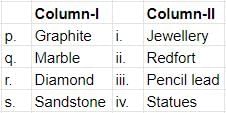
- a)p-i, q-iii, r-iv, s-ii
- b)p-iv, q-iii, r-ii, s-i
- c)p-iii, q-iv, r-i, s-ii
- d)p-i, q-ii, r-iii, s-iv
Correct answer is option 'C'. Can you explain this answer?
Match the following rocks in Column-1 with their uses in Column-II.


a)
p-i, q-iii, r-iv, s-ii
b)
p-iv, q-iii, r-ii, s-i
c)
p-iii, q-iv, r-i, s-ii
d)
p-i, q-ii, r-iii, s-iv
|
|
Pranav Singh answered |
The correct combinations are graphite - pencil lead, marble - statues, diamond - jewellery, sandstone - redfort.
What is water?- a)A kind of food
- b)A liquid we drink
- c)A type of toy
- d)A type of clothing
Correct answer is option 'B'. Can you explain this answer?
a)
A kind of food
b)
A liquid we drink
c)
A type of toy
d)
A type of clothing
|
|
Niti verma answered |
Water: A Liquid We Drink
Water is a vital substance for all living organisms on Earth. It is a transparent, tasteless, and odorless liquid that covers approximately 71% of the planet's surface. Water exists in three states: solid (ice), liquid, and gas (water vapor). In this case, we are focusing on water as a liquid that we drink.
Importance of Water
Water plays a crucial role in maintaining the overall health and well-being of our bodies. It has several essential functions, including:
1. Hydration: Water is the primary component of our body fluids and is necessary for proper hydration. It helps regulate body temperature, lubricates joints, and aids in digestion.
2. Transportation: Water enables the transportation of nutrients, oxygen, and waste products throughout our body. It helps in the absorption and distribution of essential nutrients, ensuring the proper functioning of our cells and organs.
3. Metabolism: Water is involved in various metabolic processes within the body. It participates in chemical reactions, such as breaking down food and converting it into energy.
4. Waste Removal: Water helps flush out waste products and toxins from our bodies through urine, sweat, and bowel movements. It is essential for maintaining healthy kidney function.
5. Lubrication: Water acts as a lubricant for our joints, preventing friction and reducing the risk of injuries. It also keeps our eyes, mouth, and other mucous membranes moist.
6. Body Temperature Regulation: Water has a high heat capacity, which means it can absorb and release heat without a significant change in its own temperature. This property helps regulate our body temperature, preventing overheating or hypothermia.
7. Brain Function: Proper hydration is essential for optimal brain function. Water helps improve cognitive performance, concentration, and memory.
Conclusion
Water is a vital liquid that we drink to sustain life. Its importance cannot be overstated, as it is involved in numerous bodily functions. By understanding the significance of water and ensuring adequate hydration, we can maintain our health and well-being.
Water is a vital substance for all living organisms on Earth. It is a transparent, tasteless, and odorless liquid that covers approximately 71% of the planet's surface. Water exists in three states: solid (ice), liquid, and gas (water vapor). In this case, we are focusing on water as a liquid that we drink.
Importance of Water
Water plays a crucial role in maintaining the overall health and well-being of our bodies. It has several essential functions, including:
1. Hydration: Water is the primary component of our body fluids and is necessary for proper hydration. It helps regulate body temperature, lubricates joints, and aids in digestion.
2. Transportation: Water enables the transportation of nutrients, oxygen, and waste products throughout our body. It helps in the absorption and distribution of essential nutrients, ensuring the proper functioning of our cells and organs.
3. Metabolism: Water is involved in various metabolic processes within the body. It participates in chemical reactions, such as breaking down food and converting it into energy.
4. Waste Removal: Water helps flush out waste products and toxins from our bodies through urine, sweat, and bowel movements. It is essential for maintaining healthy kidney function.
5. Lubrication: Water acts as a lubricant for our joints, preventing friction and reducing the risk of injuries. It also keeps our eyes, mouth, and other mucous membranes moist.
6. Body Temperature Regulation: Water has a high heat capacity, which means it can absorb and release heat without a significant change in its own temperature. This property helps regulate our body temperature, preventing overheating or hypothermia.
7. Brain Function: Proper hydration is essential for optimal brain function. Water helps improve cognitive performance, concentration, and memory.
Conclusion
Water is a vital liquid that we drink to sustain life. Its importance cannot be overstated, as it is involved in numerous bodily functions. By understanding the significance of water and ensuring adequate hydration, we can maintain our health and well-being.
What should we do to save our Earth?- a)We should not turn on the lights all day
- b)We should not kill or hurt animals in the wild
- c)We should not use recycled paper
- d)Both (a) and (b)
Correct answer is option 'D'. Can you explain this answer?
What should we do to save our Earth?
a)
We should not turn on the lights all day
b)
We should not kill or hurt animals in the wild
c)
We should not use recycled paper
d)
Both (a) and (b)
|
|
Rahul Desai answered |
We should use recycled paper to save our Earth.


What happens to water when we freeze it?- a)It turns into steam
- b)It becomes solid ice
- c)It disappears
- d)It becomes a gas
Correct answer is option 'B'. Can you explain this answer?
a)
It turns into steam
b)
It becomes solid ice
c)
It disappears
d)
It becomes a gas
|
|
Aditi Sharma answered |
When we freeze water, it becomes solid ice. Ice is the frozen form of water and feels cold and hard. It doesn't turn into steam or a gas when we freeze it.
Which of the following is used to make pencil lead?- a)Gemstone
- b)Graphite
- c)Diamond
- d)Garnet
Correct answer is option 'B'. Can you explain this answer?
Which of the following is used to make pencil lead?
a)
Gemstone
b)
Graphite
c)
Diamond
d)
Garnet
|
|
Pranav Singh answered |
Graphite is used to make pencil lead.
Which season is shown in the given picture?
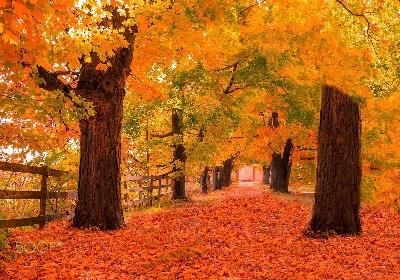
- a)Summer
- b)Autumn
- c)Spring
- d)Winter
Correct answer is option 'B'. Can you explain this answer?
Which season is shown in the given picture?


a)
Summer
b)
Autumn
c)
Spring
d)
Winter
|
|
Rahul Desai answered |
In autumn season, leaves first turn yellow and then fall off from trees.
Which of the following is a water body?- a)Peninsula
- b)Plateau
- c)Mountain
- d)Lake
Correct answer is option 'D'. Can you explain this answer?
Which of the following is a water body?
a)
Peninsula
b)
Plateau
c)
Mountain
d)
Lake
|
|
Rahul Desai answered |
Peninsula, plateau, and mountain are landforms.
Therefore, Lake is a water body.
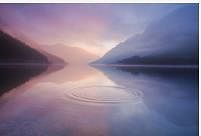
Therefore, Lake is a water body.

Name the highest mountain in the world.- a)Mount K2
- b)Mount Kanchenjunga
- c)Mount Manaslu
- d)Mount Everest
Correct answer is option 'D'. Can you explain this answer?
Name the highest mountain in the world.
a)
Mount K2
b)
Mount Kanchenjunga
c)
Mount Manaslu
d)
Mount Everest
|
|
Swati Sharma answered |
Mount Everest is Earth's highest mountain above sea level, located in the Mahalangur Himal sub-range of the Himalayas.
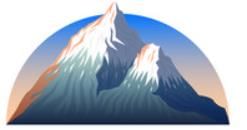

Which part of the Earth is the hottest?- a)Core
- b)Crust
- c)Mantle
- d)None of the above
Correct answer is option 'A'. Can you explain this answer?
Which part of the Earth is the hottest?
a)
Core
b)
Crust
c)
Mantle
d)
None of the above
|
|
Naina Sharma answered |
Core is the hottest layer of the Earth having temperature of approximately. 50,000 degree Celsius.
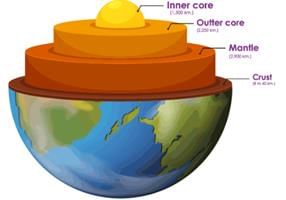

Identify the landforms shown in the given picture.
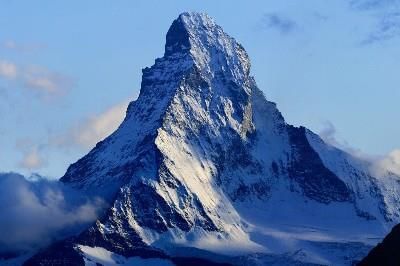
- a)Plateau
- b)Mountain
- c)Plain
- d)Valley
Correct answer is option 'B'. Can you explain this answer?
Identify the landforms shown in the given picture.


a)
Plateau
b)
Mountain
c)
Plain
d)
Valley
|
|
Neha Verma answered |
Mountain is an elevated part of land which is very high and steep.
Chapter doubts & questions for Earth’s Landscape - Science for Grade 2 2025 is part of Grade 2 exam preparation. The chapters have been prepared according to the Grade 2 exam syllabus. The Chapter doubts & questions, notes, tests & MCQs are made for Grade 2 2025 Exam. Find important definitions, questions, notes, meanings, examples, exercises, MCQs and online tests here.
Chapter doubts & questions of Earth’s Landscape - Science for Grade 2 in English & Hindi are available as part of Grade 2 exam.
Download more important topics, notes, lectures and mock test series for Grade 2 Exam by signing up for free.
Science for Grade 2
40 videos|133 docs|77 tests
|

Contact Support
Our team is online on weekdays between 10 AM - 7 PM
Typical reply within 3 hours
|
Free Exam Preparation
at your Fingertips!
Access Free Study Material - Test Series, Structured Courses, Free Videos & Study Notes and Prepare for Your Exam With Ease

 Join the 10M+ students on EduRev
Join the 10M+ students on EduRev
|

|
Create your account for free
OR
Forgot Password
OR
Signup to see your scores
go up within 7 days!
Access 1000+ FREE Docs, Videos and Tests
Takes less than 10 seconds to signup








